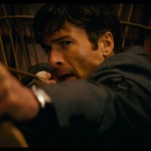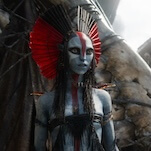Eric Drooker: Blood Song: A Silent Ballad

If a picture is worth a thousand words, Eric Drooker's books are worth a million or so each, but he doesn't even bother with one. Like Drooker's acclaimed Flood!, the hefty new Blood Song tells a story entirely with pictures, almost in the manner of a children's book, but with an adult depth of emotion. But where the near-wordless Flood! followed a shadowed Everyman through an oppressive urban landscape, Blood Song begins more organically, with a fisherman and his family on a pastoral tropical island. Though he swoops from world-encompassing views to tiny personal details, Drooker follows one continuous stream of consciousness from first to last: After a meal of fish and a night of rest, a woman from the fisherman's family travels to the river to fetch water, but returns to find faceless, iconic soldiers slaughtering her people and burning their huts. She flees into the forest, crosses the island, and leaves in a small rowboat, embarking on a grandly symbolic journey out of her broken paradise and into the hostile urban world seen in the previous book. In a few scenes, Flood! featured a dark-haired woman in a simple white dress; Blood Song seems to feature that same character as a protagonist, though Drooker's story is so consciously iconic that both women can simply be seen as symbols for the same thing: innocence and simplicity amid the burgeoning chaos of the city. Drooker's experience as a graphic illustrator readily lends itself to a project that requires both the stylistic range to hold a reader's interest over 300 pages and the sense of harmony to blend the extremes of that range. He variously evokes woodcuts, cave paintings, propaganda posters, cartoon art, and the movement photographs of Eadweard Muybridge, but shapes each image into a seamless, almost symphonic whole. He also uses a limited color palette to astonishing effect: Working almost entirely in blacks, whites, grays, and subtle dark blues, Drooker emphasizes each color in turn to create instantly recognizable moods and tones. His protagonist's journey at times becomes slightly overwrought—in making her emblematic of all humanity, he sometimes loses sight of her own personal humanity—but the simple beauty of the art and Drooker's evocative, poignant presentation serve as a counterbalance for his minor excesses. Like any suitably rich novel, Blood Song centers on a welter of powerful mental images. Drooker simply captures them and sets them plainly on paper in place of the words he might use to describe them.








































